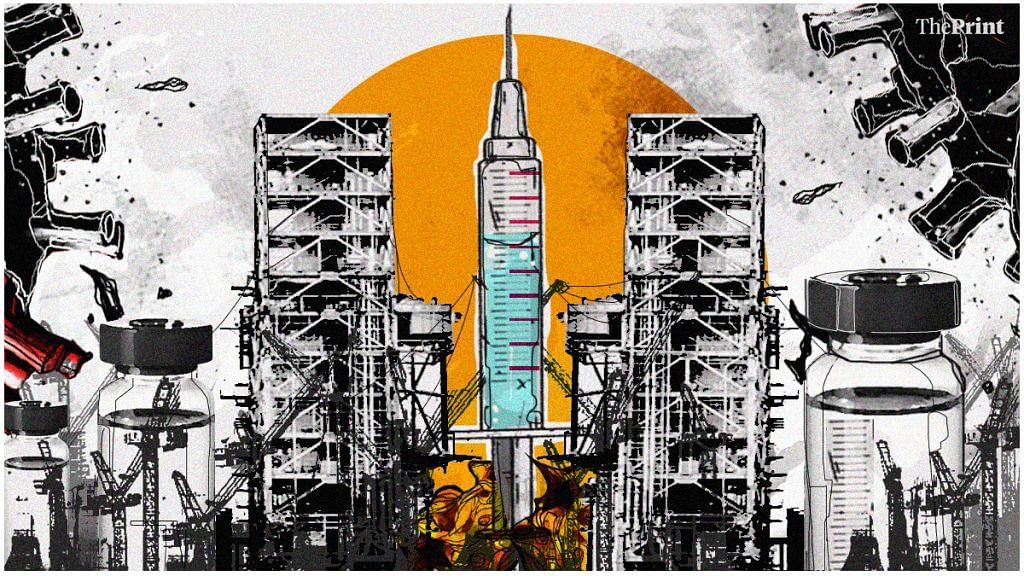On 1 May, India will start the third phase of its Covid-19 vaccination programme. The first two phases were characterised by central government’s procurement of the vaccine.
In the third phase both demand and supply are not being Centre controlled — any adult can choose to get vaccinated, and all states and institutions are allowed to buy vaccines. They can place orders for vaccines, which have been approved by regulators in India, UK, US, Europe, Japan, or are in the WHO emergency list.
With the lethal second wave being witnessed by India at the moment and the huge losses to people, to society, to the economy and to the government, it is important to speed up the vaccination programme. It is important not to be penny wise and pound foolish.
Neither companies nor governments should prioritise other expenses at this time. The total cost of vaccinating a 100 crore odd people, even at EU or US prices is less than 1 per cent of Indian GDP. It is a fraction of government expenditure at both the central and state levels. It is a fraction of the losses due to loss in GDP and taxes for the government. For private companies, the price for vaccinating the workforce is a small cost compared to the loss in output.
Also read: How India’s oxygen crisis has hit its shipbreaking industry, one of the world’s largest
Vaccination programme so far
There are about 12 crore people above 60 in India and about 30 crore between the ages of 45 and 60. By 26 April 2021, 14 crore vaccine doses had been administered. Of these 12 crore have got one dose, and 2 crore have got both doses. Of the 14 crore, about 1 crore doses have been to persons below age 40.
In the eligible population of 45+, a little less than 5 per cent have received both the doses, while a little less than 27 per cent have received the first dose.
The central government is providing vaccines at a rate of about 2.3 million per day. One calculation shows that this means that so far fewer than six persons in every 1000 of the eligible population of 45+ got vaccinated partly due to vaccine hesitancy and partly due to supply issues.
At this rate, the government would take more than two years to vaccinate even the eligible population of above 45. Considering this limited state capacity, there was a growing view that a multifold increase in energy and push should be given to the vaccination drive.
Also, as the second wave has demonstrated, it is not enough to vaccinate those above 45. New mutants are far more virulent than the original strain from Wuhan. It is reported that the share of deaths of below 50 years is now quite high.
Also read: Planned as the next Singapore in 2012, Gujarat’s Gift city still remains a work in progress
Could we have continued with business as usual?
Opening up the vaccination to those between ages 18 and 45 means that the population eligible for vaccination has gone up from about 42 crore to 100 crore. If we subtract the already vaccinated, we have an eligible population of 88 crore that needs to be vaccinated as fast as possible.
Even to maintain the present rate of vaccination, the number of doses per day would need to roughly double.
As the cases increased, the demand from the 45+ age group appears to have increased and supply shortages were reported.
If only the central government were to procure and administer the vaccine, there would likely be a larger mismatch between demand and supply. The new system would allow others to procure the vaccine and administer it.
Are concerns about ‘monopoly’ pricing valid?
There are many objections being raised about the new design of the Covid-19 vaccination programme.
Primarily, some opposition state governments are demanding that the Narendra Modi government procure the vaccines and provide them to the states. The Centre is arguing that it is already providing the states vaccines free for those above 45, and that the states can purchase for the 18-45 age group if they wish to.
Critics also argue that vaccine companies will make supernormal profits if they are allowed to sell at a higher price.
There are five big vendors today — AstraZeneca, Moderna, Pfizer, Johnson and Johnson and Sputnik, not a single monopolist in the market. This allows for a legitimate price to be negotiated in the market.
Let us assume that each state pays Rs 1,000 per dose (that is approximately at international prices). For 60 crore people the cost is Rs 1.2 lakh crore for two doses. At Rs 300 per dose that SII is offering them at, it would cost states a total of Rs 36,000 crore out of the total expenditure of states of Rs 40 lakh crore (according to BE 2020-21).
One well understood concept in economics is an upward sloping supply curve. If you want more, and are willing to pay more, there will be more supply.
Today we in India need the vaccine more than some of the other countries do. If we can outbid them and secure supplies for our people, the higher price we pay could well outweigh the additional cost.
The negative externality from the new mutant strain is huge. Almost no one is left untouched. Those who have not taken the vaccine are seeing among the worst symptoms and our health system is collapsing.
Revamping health systems cannot be done in a hurry as doctors and nurses take years to be trained. This is neither the time for vaccine hesitancy nor for watching our pockets. Indeed, if we can secure supplies of the third booster dose, let us do so.
Also read: Why higher inflation could be India’s next big worry amid worsening Covid crisis
